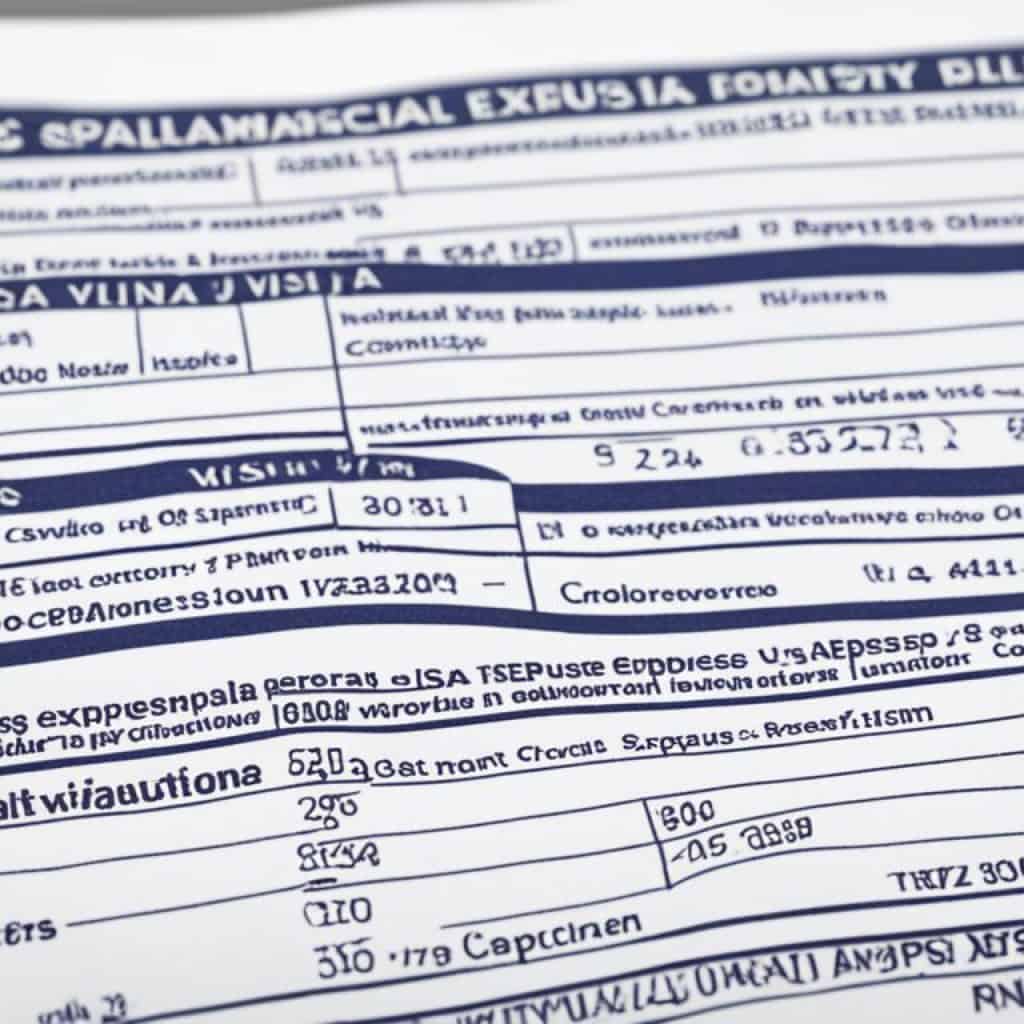Are you ready to embark on the journey of obtaining a spousal visa in the United States? The process may seem daunting, but with the right knowledge and guidance, you can navigate through it successfully. Whether you’re a foreign spouse seeking to join your loved one in the US or a US citizen seeking to bring your foreign spouse to the country, understanding the spousal visa process is crucial.
From the US spouse visa requirements to the spouse visa process and everything in between, this comprehensive guide will provide you with the information you need to know. Say goodbye to confusion and uncertainty, and say hello to clarity and confidence as we unravel the complexities of spousal visas and green cards through marriage.
Key Takeaways:
- Understanding the spousal visa process is essential for anyone seeking to obtain a green card through marriage in the United States.
- The US spouse visa requirements and the step-by-step spouse visa process are crucial aspects to be aware of.
- Knowing the average processing time, costs, required forms, and other important details will help you navigate the spousal visa journey with confidence.
- Comparing the CR1 visa and IR1 visa and understanding the eligibility criteria for each can guide you in making the right choice for your situation.
- Exploring the differences between the fiancé visa and spouse visa can help you determine which option is best suited for you and your loved one.
Understanding the Spousal Visa Process
Applying for a spousal visa and obtaining a green card through marriage is an important and complex process. It involves several steps and requirements that need careful attention and preparation. In this section, we will guide you through the step-by-step process of obtaining a spousal visa in the United States.
Step 1: Determine Your Eligibility
Before beginning the spousal visa process, it’s crucial to ensure that you meet the eligibility criteria. This includes being legally married to a U.S. citizen or permanent resident, providing evidence of a genuine marital relationship, and meeting specific financial requirements. It’s essential to thoroughly review the eligibility criteria to avoid any complications during the application process.
Step 2: Submit Form I-130
The first official step in the spousal visa process is filing Form I-130, Petition for Alien Relative. This form establishes that the petitioner is a U.S. citizen or permanent resident and is sponsoring their spouse for a green card. It’s important to carefully complete the form and submit it along with any required supporting documents to the appropriate USCIS office.
Step 3: Wait for USCIS Approval
After submitting Form I-130, USCIS will review your application and conduct background checks to verify the information provided. The processing time for the I-130 petition can vary, so it’s important to regularly check the USCIS website for updates on processing times. Once USCIS approves the I-130 petition, it will be forwarded to the National Visa Center (NVC) for further processing.
Step 4: Complete Form DS-260
Upon receiving the approved I-130 petition from USCIS, the NVC will notify the petitioner and provide instructions for completing Form DS-260, the Online Immigrant Visa Application. This form collects information about the intending immigrant and their background. It’s crucial to complete this form accurately and truthfully to avoid delays or complications in the visa application process.
Step 5: Attend the Spouse Visa Interview
After submitting Form DS-260 and supporting documents to the NVC, the next step is to attend the spousal visa interview at the U.S. embassy or consulate in your home country. The interview is a crucial part of the process where the consular officer will assess the validity of the marriage and the eligibility of the applicant for a spousal visa. It’s essential to prepare thoroughly for the interview by practicing common interview questions and ensuring that you have all required documents and evidence of your relationship.
Step 6: Receive the Spousal Visa and Enter the U.S.
If the consular officer approves the spousal visa application, you will receive your visa, allowing you to travel to the United States as a lawful permanent resident. Upon entering the U.S., you will be issued a green card, which serves as proof of your permanent residency status. It’s crucial to familiarize yourself with the rights and responsibilities of being a green card holder to ensure compliance with U.S. immigration laws.
Understanding the spousal visa process is essential for a smooth and successful application. By following the steps outlined above and carefully preparing your application, you can navigate the process with confidence and increase your chances of obtaining a green card through marriage.
Timeframe for Spousal Visa Application Approval
Applying for a spousal visa and obtaining a green card through marriage is an exciting step towards building a life together in the United States. However, it’s important to understand that the process takes time. The timeframe for spousal visa application approval can vary depending on various factors, including the complexity of the case and the workload of the United States Citizenship and Immigration Services (USCIS).
Processing Time for Spousal Visa Application
On average, the processing time for a spousal visa application, from submission to approval, can range from several months to over a year. It’s important to note that these timelines are approximate and can change based on individual circumstances and USCIS workload.
Below is a general breakdown of the typical processing stages:
| Processing Stage | Estimated Timeframe |
|---|---|
| Submission of Spousal Visa Application | Varies |
| USCIS Initial Review | 2-3 months |
| Biometrics Appointment | 1-2 months |
| Spousal Visa Interview | 1-4 months |
| USCIS Decision | 2-6 months |
| Green Card Delivery | 1-2 months |
Please note that these timeframes are merely estimations and can be subject to change. It’s crucial to stay updated with the latest processing times provided by the USCIS and consult with a qualified immigration attorney for personalized guidance.
During the application processing, it’s natural to feel excited, anxious, or even frustrated. Remember to remain patient and continue gathering any necessary evidence or supporting documentation that may be requested by USCIS throughout the process.
Additionally, it’s advisable to avoid making any travel plans outside of the United States until the green card is in hand, as international travel can complicate the process.
Now that you have a better understanding of the timeframe for spousal visa application approval, let’s move on to the next section and explore the costs associated with the application process.
Cost of Spousal Visa Application
Applying for a spousal green card involves certain costs that applicants need to be aware of. These expenses include government fees and medical examination costs. Understanding the estimated cost of a spousal green card can help applicants plan their finances accordingly.
Government Fees
When filing the spousal visa application, there are several government fees that must be paid. These fees are non-refundable and subject to change. The exact amount may vary depending on the specific visa category and current USCIS regulations. Here are the common government fees associated with a spousal visa application:
| Government Fees | Amount |
|---|---|
| I-130 Petition for Alien Relative | $535 |
| I-485 Application to Register Permanent Residence or Adjust Status | $1,140 |
| I-765 Application for Employment Authorization | $550 (if applying concurrently with I-485) |
| I-131 Application for Travel Document | $590 (if applying concurrently with I-485) |
| I-693 Report of Medical Examination and Vaccination Record | Cost varies (paid directly to the authorized physician) |
Please note that these fees are as per the current USCIS fee schedule and are subject to change. It is important to verify the latest fees on the official USCIS website.
Medical Examination Costs
As part of the spousal visa application process, the applicant is required to undergo a medical examination by a designated civil surgeon. The cost of the medical examination may vary depending on the physician and location. Typically, the medical examination includes a physical examination, vaccinations, and required lab tests. The applicant is responsible for covering the cost of the medical examination, which is paid directly to the authorized physician.
It is essential to budget for both the government fees and the medical examination costs while preparing the spousal visa application.

Required Forms for Spousal Visa Application
When applying for a spousal visa, it is important to submit a complete application package that includes all the necessary forms and supporting documents. Failure to include any required forms can delay the processing of your application or even result in a denial. To ensure a smooth and successful application process, here are the key forms that you need to include in your spousal visa application package:
1. Form I-130, Petition for Alien Relative
The Form I-130 is the initial step in the spousal visa application process. This form is used to establish the relationship between the petitioner (the U.S. citizen or lawful permanent resident sponsoring their spouse) and the beneficiary (the foreign spouse seeking a green card).
2. Form I-130A, Supplemental Information for Spouse Beneficiary
The Form I-130A is a supporting document that must be submitted along with Form I-130. It provides additional information about the foreign spouse, including their biographic details and history of travel and residence.
3. Form I-864, Affidavit of Support
The Form I-864 is a crucial document that demonstrates the petitioner’s ability to financially support the foreign spouse. By submitting this form, the petitioner agrees to sponsor their spouse and assume financial responsibility for them during their adjustment of status process.
4. Form DS-260, Online Immigrant Visa Application
Form DS-260 is an online application form that must be completed by the foreign spouse. It collects biographic information, contact details, educational background, and employment history. The form is submitted electronically to the National Visa Center (NVC) for processing.
5. Supporting Documents
In addition to the required forms, your spousal visa application package should include various supporting documents to substantiate your eligibility and the genuineness of your marital relationship. These documents may include:
- Marriage certificate
- Passports and birth certificates
- Police clearance certificates
- Proof of termination of prior marriages (divorce decree, death certificate)
- Photographs showing the couple together
- Joint financial documents (bank statements, tax returns)
- Proof of joint assets or property
- Affidavits from friends and family attesting to the marital relationship
It is important to carefully review the official USCIS website, as specific requirements may vary depending on your unique circumstances. By submitting a complete spousal visa application package with all the necessary forms and supporting documents, you increase your chances of a successful application and a timely approval.
“Submitting a complete spousal visa application package is essential to avoid delays or denials.”
| Required Forms | Description |
|---|---|
| Form I-130 | Petition for Alien Relative |
| Form I-130A | Supplemental Information for Spouse Beneficiary |
| Form I-864 | Affidavit of Support |
| Form DS-260 | Online Immigrant Visa Application |
Additional Forms for Employment and Travel
Along with the main spousal visa application package, there are additional forms that can enhance your ability to work and travel while your application is being processed. These forms include the work permit application and the travel permit application.
Work Permit Application
Applying for a work permit allows you, as the spouse of a U.S. citizen or permanent resident, to legally work in the United States while your spousal visa application is pending. The work permit, also known as an Employment Authorization Document (EAD), can provide financial stability and greater opportunities as you navigate through the immigration process.
When completing the work permit application, make sure to provide accurate and up-to-date information about your employment history, education, and any relevant qualifications or skills. This will help increase your chances of obtaining a work permit as quickly as possible.
Remember, the work permit application should be submitted together with your spousal visa application package to avoid any delays.
Travel Permit Application
If you anticipate the need to travel outside of the United States while your spousal visa application is in process, it is recommended to include a travel permit application (Form I-131) in your application package. This travel permit, also known as an Advance Parole Document (AP), allows you to reenter the United States without jeopardizing your spousal visa application.
It is essential to obtain the travel permit before leaving the country, as traveling without proper authorization may result in the denial of your spousal visa application.
When completing the travel permit application, provide the necessary information and reasons for your travel plans. This will help USCIS understand the purpose of your departure and ensure a smooth reentry process.
Remember, the travel permit application should be submitted together with your spousal visa application package to avoid any complications or delays in your immigration journey.
“Including the work permit and travel permit applications in your spousal visa application package can provide you with the flexibility to work and travel while awaiting the final decision on your visa. This ensures that you can continue to support yourself and your family and maintain a sense of normalcy during this important and often stressful process.”
Having a work permit and a travel permit can greatly benefit spousal visa applicants, offering both financial security and the freedom to travel when necessary. These additional forms demonstrate your commitment to building a future in the United States and contribute to a well-rounded spousal visa application package.
USCIS Fees for Spousal Visa Application
When applying for a spousal green card, it’s important to be aware of the USCIS fees involved. These fees cover the processing and adjudication of your application and are required to be paid to the United States Citizenship and Immigration Services (USCIS).
Below is a breakdown of the USCIS fees for a spousal visa application:
| Fee Description | Amount |
|---|---|
| Filing Form I-130, Petition for Alien Relative | $535 |
| National Visa Center (NVC) Processing Fee | $445 |
| Immigrant Visa Application Processing Fee | $325 |
| Medical Examination | Varies – approximately $200 to $500 |
| Biometrics Fee | $85 |
| Total Estimated USCIS Fees | $1,590 to $2,190 |
It’s important to note that these USCIS fees are subject to change and may vary depending on factors such as your location and the specific circumstances of your case. To obtain the most accurate and up-to-date information, it’s recommended to check the official USCIS website or consult with an immigration attorney.
Once you have gathered the necessary funds, there are multiple payment options available, including online payment through the USCIS website, by mail using a check or money order, or through electronic payment methods such as credit or debit cards.
Being aware of the USCIS fees and ensuring timely payment is an essential step in the spousal visa application process. By understanding the financial requirements, you can plan your budget accordingly and avoid any delays or issues in your application.

Biometrics Appointment for Spousal Visa Application
Once you have submitted your spousal visa application, the next step in the process is the biometrics appointment. This appointment is a crucial part of the application process and involves providing your fingerprints, photograph, and signature for identity verification.
During the biometrics appointment, you will need to visit a designated Application Support Center (ASC) to complete the necessary procedures. This appointment allows the U.S. Citizenship and Immigration Services (USCIS) to collect biometric information from applicants to conduct background checks.
It is important to arrive at the ASC on time for your appointment and bring the required documents, which typically include your appointment notice and a valid form of identification such as your passport. The ASC staff will guide you through the process and ensure that all necessary information is collected.
After your biometrics appointment, USCIS will process your fingerprints and other biometric data to conduct the necessary background checks. This step is crucial for ensuring the security and integrity of the immigration process.
Once the background checks are completed, USCIS will continue processing your spousal visa application. It is important to note that the biometrics appointment is just one step in the overall process, and it may take several months for your application to be processed and for a decision to be made.
Having a complete understanding of the biometrics appointment process and what to expect can help alleviate any concerns or uncertainties you may have during this stage of your spousal visa application.
What to Bring to Your Biometrics Appointment:
- Appointment Notice
- Valid Form of Identification (e.g., Passport)
| Benefits of the Biometrics Appointment | Considerations for the Biometrics Appointment |
|---|---|
| – Provides essential biometric information for identity verification and background checks. | – Ensure you arrive on time and bring all required documents to avoid delays. |
| – Contributes to the overall security and integrity of the spousal visa application process. | – Follow the instructions provided by USCIS regarding the specific biometrics appointment procedures. |
| – Allows USCIS to conduct background checks to ensure eligibility and admissibility. | – Be prepared to provide your fingerprints, photograph, and signature during the appointment. |
Request for Evidence (RFE) in Spousal Visa Application
When applying for a spousal visa, it’s important to be aware of the possibility of receiving a Request for Evidence (RFE) from the U.S. Citizenship and Immigration Services (USCIS). An RFE is a notice sent by USCIS requesting additional documentation or evidence to further support your spousal visa application. It is not uncommon to receive an RFE, and it does not necessarily mean that your application will be denied.
How to Respond to an RFE:
1. Read the RFE Carefully: Carefully review the RFE to understand exactly what additional information or evidence is being requested. Take note of the deadline for response and any specific instructions provided.
2. Gather the Requested Documents: Collect all the documents and evidence requested in the RFE. Make sure to provide clear and complete documentation to address the specific concerns raised by USCIS.
3. Include an Explanatory Cover Letter: Write a cover letter in response to the RFE, addressing each request individually. Clearly explain how the submitted documents fulfill the requirements and address any concerns raised by USCIS.
4. Organize and Label Documents: Ensure that all the documents are organized and properly labeled for easy reference by USCIS. Use dividers or tabs to separate different sections of the response.
5. Keep a Copy: Make copies of your entire response package, including the RFE and all the documents you submit. This will serve as a record of your response and can be helpful for future reference.
| Common reasons for receiving an RFE: | How to address the RFE: |
|---|---|
| Lack of evidence to prove the validity of the marriage | Gather additional proof of your marital relationship, such as joint bank statements, lease agreements, or utility bills. |
| Incomplete or incorrect forms | Review your application package thoroughly and ensure that all the necessary forms are completed accurately and submitted with the required supporting documentation. |
| Insufficient financial support evidence | Provide additional financial documents, such as tax returns, employment letters, or bank statements, to demonstrate your ability to financially support your spouse. |
It’s important to respond to an RFE promptly and provide all requested documentation to increase your chances of a successful spousal visa application. If you have any concerns or questions regarding the RFE, consider seeking guidance from an experienced immigration attorney who can assist you in preparing a strong response.
The Spousal Visa Interview
Once your spousal visa application has been submitted and processed, the next crucial step in the journey to obtaining a marriage green card is the spousal visa interview. This interview is an opportunity for US immigration officials to assess the authenticity of your marriage and determine if you meet the eligibility criteria for a green card through marriage.
During the spousal visa interview, you and your spouse will be questioned separately to ensure consistency in your answers. The purpose of these interviews is to evaluate the bona fides of your marriage and detect any potential fraud or misrepresentations.
To help you prepare for the spousal visa interview, it’s important to familiarize yourself with the type of questions that may be asked. While every interview is unique, common topics covered in the interview may include:
- Details about your relationship history
- Personal background information
- Living arrangements and shared finances
- Important milestones in your relationship
- Plans for the future
It’s essential to be honest and provide accurate information during the spousal visa interview. USCIS officers are trained to identify discrepancies or inconsistencies in your responses, which could have serious consequences for your immigration application.
To increase your chances of a successful spousal visa interview, consider the following tips:
- Thoroughly review your visa application to ensure you are familiar with all the information provided.
- Prepare supporting documents to validate your marriage, such as joint bank account statements, lease agreements, or photographs.
- Practice answering interview questions with your spouse to improve your confidence and consistency.
- Arrive early on the day of the interview and dress in a professional manner.
- Remain calm and composed throughout the interview process.
Remember, the spousal visa interview plays a crucial role in determining the fate of your green card application. By adequately preparing and presenting your case truthfully, you can increase your chances of a successful outcome.
“The spousal visa interview is an opportunity to demonstrate the authenticity of your marriage. Careful preparation and honest responses are essential to a successful outcome.” – [Your Name]
| Common Questions Asked in the Spousal Visa Interview | Suggested Responses |
|---|---|
| Can you describe how you and your spouse met? | Provide a detailed account of how you first met, including the circumstances and any significant events surrounding your initial meeting. |
| What was your wedding ceremony like? | Explain the details of your wedding ceremony, including the date, venue, and any religious or cultural traditions that were incorporated. |
| How do you and your spouse share finances? | Describe your financial arrangements, such as joint bank accounts, shared expenses, or investments made together. |
| What are your plans for the future? | Outline your future goals as a couple, including any plans for starting a family, purchasing a home, or furthering your education. |
Approval and Receipt of the Spousal Visa
After successfully completing the spousal visa interview, the next steps involve the approval of your visa and the receipt of your green card. While the exact process and timeline may vary, it is important to be aware of what to expect during this stage of your immigration journey.
Upon the conclusion of your interview, the USCIS officer will determine whether your spousal visa application is approved. In some cases, you may receive immediate approval, meaning that you will be granted the visa on the spot. This is great news as it allows you to move forward with your plans to live and work in the United States as a lawful permanent resident.
If immediate approval is not granted, don’t panic. It is not uncommon for USCIS to require additional administrative processing before making a final decision. This may include further background checks or the need for additional documentation. In such cases, you will receive notification from USCIS regarding the next steps to take.
Once your spousal visa application is approved, you can expect to receive the physical green card in the mail. This serves as evidence of your lawful permanent resident status and grants you the ability to live and work in the United States. It is important to keep the green card safe and carry it with you at all times, as it will be required for various purposes, such as employment verification or reentry into the country.
Receiving the green card is a significant achievement, as it allows you to enjoy the benefits and opportunities afforded to lawful permanent residents in the United States. It demonstrates your commitment to building a life in the country and opens up a world of possibilities for you and your family.
Types of Green Cards Based on Marriage Length
Upon approval of a spousal visa application, the type of green card received can vary based on the length of the marriage at the time of approval. There are two main types of green cards issued in these cases:
| Green Card Type | Explanation |
|---|---|
| CR1 (Conditional Green Card) | This type of green card is issued when the marriage is less than two years old at the time of visa approval. It is a conditional status that requires the couple to file a joint petition to remove the conditions within the 90-day period before the two-year anniversary of the green card approval. |
| IR1 (Immediate Relative Green Card) | If the marriage is two years or older at the time of visa approval, the green card issued is an IR1, which grants permanent resident status with no conditions attached. The IR1 green card is valid for ten years. |
The distinction between the CR1 and IR1 green cards is significant, as it affects the steps required to maintain permanent resident status in the United States. It is essential for couples to understand the implications of each green card type and fulfill the necessary obligations accordingly.
CR1 Visa vs. IR1 Visa
When applying for a spousal visa, there are two common categories to consider: the CR1 visa and the IR1 visa. While both options lead to obtaining a green card, there are important differences between them. Let’s explore these differences to help you make an informed decision for your immigration journey.
First, let’s understand what the acronyms CR1 and IR1 stand for:
- CR1 Visa: The CR1 visa stands for “Conditional Resident 1” and is granted to spouses who have been married for less than two years at the time of visa approval.
- IR1 Visa: The IR1 visa stands for “Immediate Relative 1” and is issued to spouses who have been married for more than two years at the time of visa approval.
It is important to note that both the CR1 and IR1 visas are part of the immediate relative category, which allows for faster processing times compared to other family-based visas.
Comparison:
| CR1 Visa | IR1 Visa |
|---|---|
| The CR1 visa is issued to spouses who have been married for less than two years. | The IR1 visa is issued to spouses who have been married for more than two years. |
| A conditional green card is initially granted, which is valid for two years. | An immediate relative green card is granted, which is valid for ten years. |
| Within the 90-day period before the conditional green card expires, the spouse must apply to remove the conditions and obtain a permanent green card. | The immediate relative green card is already a permanent green card and does not require removal of conditions. |
| The CR1 visa process may take longer as additional steps are involved for the removal of conditions. | The IR1 visa process may be faster as there is no need to remove conditions. |
When deciding between the CR1 and IR1 visas, consider the length of your marriage and the processing timeline you prefer. If you have been married for less than two years, the CR1 visa may be suitable for you, but be mindful of the additional steps involved in removing the conditions. On the other hand, if you have been married for more than two years, the IR1 visa may offer a faster and more streamlined path to a permanent green card.
Remember, every individual case is unique, and it’s crucial to consult with an experienced immigration attorney or legal professional to determine the best visa option for your specific circumstances.
Eligibility and Requirements for CR1/IR1 Visa
Obtaining a CR1 or IR1 visa, also known as a spousal visa, requires meeting specific eligibility criteria and adhering to certain requirements. These visas are designed for individuals seeking to join their U.S. citizen or lawful permanent resident spouse in the United States. Below, we outline the key factors to consider when applying for a CR1/IR1 visa:
- Marriage: The applicant must be legally married to a U.S. citizen or lawful permanent resident. It is important to note that a marriage certificate obtained through proxy, telephone, or the internet may not be recognized for immigration purposes.
- Validity of Marriage: The marriage must be considered valid under U.S. law. This means that it must be a legally recognized marriage and not a common-law or same-sex marriage in jurisdictions that do not recognize such unions.
- Intent to Reside: The applicant must demonstrate a genuine intention to establish a marital relationship and live together with their U.S. citizen or lawful permanent resident spouse in the United States.
- Financial Support: The U.S. petitioner must meet the income requirements to prove their ability to financially support the foreign spouse. This ensures that the applicant will not become a public charge upon their arrival in the United States.
- Age and Consanguinity: Both parties must meet the legal age requirements for marriage in their respective jurisdictions. Additionally, the marriage must not be considered incestuous or bigamous under U.S. law.
- Good Moral Character: The applicant must have a clean criminal record and demonstrate good moral character. USCIS conducts background checks to ensure the safety and security of the United States.
These are general eligibility and requirements for a CR1/IR1 visa. It’s important to note that each case is unique, and additional documentation may be required based on the individual circumstances. Consulting with an experienced immigration attorney can provide valuable guidance throughout the application process.
Spousal Visa Requirements Comparison Table
| Requirement | CR1 Visa | IR1 Visa |
|---|---|---|
| Marriage to a U.S. Citizen or LPR | Required | Required |
| Validity of Marriage | Must be legally recognized | Must be legally recognized |
| Intent to Reside | Must demonstrate intention to live together in the U.S. | Must demonstrate intention to live together in the U.S. |
| Financial Support | U.S. petitioner must meet income requirements | U.S. petitioner must meet income requirements |
| Age and Consanguinity | Must meet legal age requirements and not be considered incestuous or bigamous | Must meet legal age requirements and not be considered incestuous or bigamous |
| Good Moral Character | Must have a clean criminal record and demonstrate good moral character | Must have a clean criminal record and demonstrate good moral character |

Fiancé Visa vs. Spouse Visa: Which is Right for You?
When it comes to bringing your foreign partner to the United States to start your life together, you have two main visa options: the fiancé visa (K-1 visa) and the spouse visa (CR-1/IR-1 visa). Understanding the differences between these visas is crucial in determining which option is right for you and your future spouse.
Speed and Process
The fiancé visa is known for its relatively quicker processing time compared to the spouse visa. With the K-1 visa, you can expect a faster approval process, allowing your fiancé to join you in the U.S. sooner. However, it’s important to note that after your fiancé arrives in the U.S., you will have 90 days to get married and file for an adjustment of status to obtain a green card.
In contrast, the spouse visa requires couples to get married before the visa application process begins. The CR-1/IR-1 visa process may take longer than the fiancé visa, but once approved, your spouse will enter the U.S. as a lawful permanent resident with a green card, providing immediate authorization to work and live in the country.
Cost
The cost of the fiancé visa and spouse visa application can vary. The K-1 visa typically has fewer government fees associated with it, while the CR-1/IR-1 visa may have additional costs such as the Affidavit of Support and Consular Interview fees. It’s essential to consider your budget and financial resources when choosing between the two visas.
Documentation Requirements
Both the fiancé visa and spouse visa require thorough documentation to prove the legitimacy of the relationship. The K-1 visa requires evidence of a bona fide engagement, including joint photographs, correspondence, and proof of having met in person within the last two years. On the other hand, the CR-1/IR-1 visa application requires more substantial evidence demonstrating a genuine marital relationship, such as joint bank accounts, shared assets, and joint utility bills.
It’s crucial to consult with an experienced immigration attorney to understand the specific documentation requirements for each visa and ensure your application is strong and compelling.
| Fiancé Visa (K-1 Visa) | Spouse Visa (CR-1/IR-1 Visa) |
|---|---|
| Quicker processing time | Longer processing time |
| Requires marriage within 90 days of entry | Requires marriage prior to visa application |
| Lower government fees | Potential additional fees |
| Proof of bona fide engagement | Proof of genuine marital relationship |
Ultimately, the decision between the fiancé visa and spouse visa depends on your specific circumstances and preferences. Consider factors such as timeline, budget, and the strength of your relationship when making your choice. Remember, an immigration attorney can provide tailored guidance and support throughout the process to ensure a successful visa application.
Choosing the right visa is an important step towards building your future together in the United States. Whether you opt for the fiancé visa or the spouse visa, both routes can lead to the ultimate goal of obtaining a green card and permanent residency for your foreign partner.
Conclusion
Understanding the spousal visa process is crucial for anyone navigating the journey to obtain a green card through marriage in the United States. The path to a spousal visa can be complex, but by following the required steps and gathering the necessary documentation, you can increase your chances of success.
From understanding the application process and timeline to preparing for the spousal visa interview, each stage of the journey requires careful attention to detail. It’s essential to properly complete the required forms and submit all supporting documents to ensure a smooth application process.
By familiarizing yourself with the eligibility requirements, USCIS fees, and potential challenges like Requests for Evidence, you can better prepare yourself for the spousal visa journey. Consulting with a spouse visa lawyer can provide valuable guidance and ensure you are on the right track throughout the process.
Remember, obtaining a spousal visa and ultimately a green card through marriage is a significant milestone. By staying informed and diligently following the steps outlined in this article, you can pave the way for a successful spousal visa application, allowing you and your spouse to build a life together in the United States.
FAQ
What is a spousal visa?
A spousal visa, also known as a marriage-based visa, allows a foreign spouse of a U.S. citizen or permanent resident to enter and live in the United States. It is a pathway to obtaining a green card through marriage.
What are the requirements for a spousal visa in the US?
The requirements for a spousal visa include being legally married to a U.S. citizen or permanent resident, proving the authenticity of the marriage, meeting the financial support requirements, and passing the medical examination.
What is the process for obtaining a spousal visa?
The process for obtaining a spousal visa involves filing the necessary forms and supporting documents, attending a biometrics appointment, attending a spousal visa interview, and awaiting the approval of the visa application.
How long does it take to get a spousal visa in the US?
The average processing time for a spousal visa can vary, but it generally takes several months. This includes the time it takes to schedule and attend the spousal visa interview. Once approved, it may take additional time to receive the physical green card.
How much does a spousal visa cost?
The cost of a spousal visa includes government fees, which can range from several hundred to several thousand dollars, depending on the specific application. Additionally, there are costs associated with the required medical examination for the visa application.
What forms and documents are required for a spousal visa application?
The spousal visa application package typically includes forms such as the I-130 Petition for Alien Relative and the I-485 Application to Register Permanent Residence or Adjust Status. Supporting documents may include marriage certificates, proof of financial support, and identification documents.
Are there additional forms for employment authorization and travel permission?
Yes, spouses applying for a spousal visa can include additional forms such as the I-765 Application for Employment Authorization and the I-131 Application for Travel Document, which allow for work authorization and permission to travel outside the U.S. while the visa application is pending.
How do I pay the government fees for a spousal visa application?
The government fees for a spousal visa application can be paid online through the official U.S. government payment portal or by mail with a check or money order. It is important to follow the specific instructions provided by the U.S. Citizenship and Immigration Services (USCIS).
What happens during a biometrics appointment for a spousal visa application?
During a biometrics appointment, your fingerprints, photograph, and signature will be collected for identity verification purposes. This information will be used to conduct background checks as part of the spousal visa application process.
What is a Request for Evidence (RFE) in a spousal visa application?
A Request for Evidence (RFE) is a notice sent by the USCIS if additional documentation or clarification is needed to support a spousal visa application. It is crucial to respond to an RFE within the specified timeframe to avoid delays or possible denial of the application.
What should I expect during the spousal visa interview?
The spousal visa interview is conducted by a USCIS officer and aims to assess the authenticity of the marriage. Common questions may include details about the relationship, living arrangements, and future plans. It is important to be prepared with relevant documentation and to answer truthfully.
What happens after the spousal visa interview?
After the spousal visa interview, the USCIS officer will determine whether to approve or deny the visa application. If approved, you may receive immediate visa approval or, in some cases, a notice indicating that the decision will be mailed. The physical green card will be mailed later, if approved.
What are the different types of green cards based on the length of marriage?
The two main types of green cards based on the length of marriage at the time of visa approval are the CR1 visa (conditional green card) and the IR1 visa (immediate relative green card). The CR1 visa is valid for two years, while the IR1 visa is valid for 10 years.
What are the differences between a CR1 visa and an IR1 visa?
The main difference between a CR1 visa and an IR1 visa is the length of validity. A CR1 visa is conditional and valid for two years, while an IR1 visa is valid for 10 years. Conditional green card holders must jointly file a petition to remove conditions within the 90-day period before the card expires.
What are the eligibility criteria and specific requirements for a CR1 or IR1 visa?
The eligibility criteria for both CR1 and IR1 visas include being legally married to a U.S. citizen or permanent resident, demonstrating a bona fide marriage, meeting financial support requirements, and passing the medical examination. The specific requirements can vary, and it is important to review the USCIS guidelines for each visa type.
How does a fiance visa (K-1 visa) compare to a spouse visa (CR-1/IR-1 visa)?
When deciding between a fiance visa and a spouse visa, factors such as processing speed, cost, and documentation requirements should be considered. While a fiance visa allows the couple to get married in the U.S. within 90 days, a spouse visa allows the foreign spouse to enter the U.S. as a green card holder immediately after approval.








Add comment